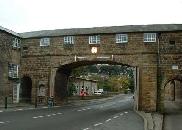Belper is perhaps most famous for its place in the Industrial Revolution, and the presence of the imposing mills that once dominated the town and its people.
It was the mills of Jedediah Strutt, on land bought for him by William Slater, that transformed Belper and brought prosperity to the town which before then was more of a hamlet.
.From a farming background in South Normanton, Jedediah worked as a wheelwright before perfecting the Derby rib machine with his brother-in-law William Woolatt. Building on early success with Richard Arkwirhgt at Cromford, Strutt moved on to build the Belper mills from around 1775. (although see below).
I understand that the first to be built was the South Mill, around 1776, then the North Mill (1784-1786) which is the only one of Strutt's mills to stand today and even that has been replaced due to a fire in 1803.
Across the road from the first site were built the West Mill (1795) and other mill buildings joined by a gangway that is now thought to have provided protection for the Counting House, also a Round Mill Building, a Reeling Mill and a Junction Mill.
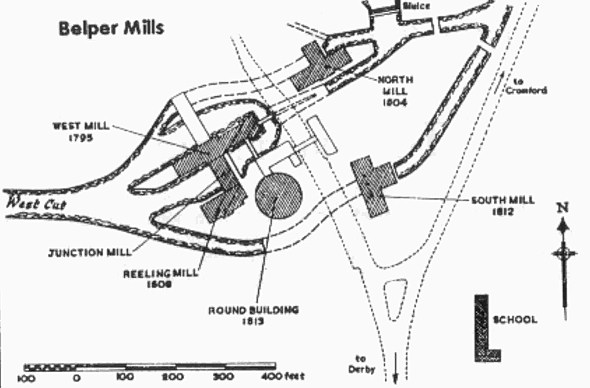
North Mill, 1804, is the oldest of the two remaining mills - West Mill, South Mill, and Round Mill, were demolished. The largest and most prominent mill building in Belper today, East Mill, was not in fact a Strutt property but was built by the English Sewing Company in 1912. This picture, produced for the English Sewing Company who built the East Mill, shows the extent and beauty of the mill site before it was demolished.
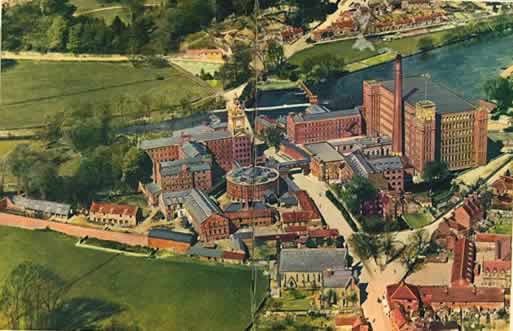
Jedediah Strutt’s first cotton mill
It is generally assumed Strutt began building his first mill in Belper in 1776. This is the date accepted by most authorities. However, the evidence of Strutt’s land purchases puts this in doubt. It was not until 1777 that he bought the first parcels of land on which he was to build, and those 10 acres, plus small purchases made a year later, secured for him the entire site on which all the Strutt mills in Belper were to be built.
The river and the adjoining land had never before accommodated a mill at this point. There were no existing weirs or water courses and Strutt had to create his own. A weir was built across the river near the present day railway bridge and a goyt, part of which survives in the River Gardens, which linked it to the mill. It is unlikely the mill could have been ready for use in 1778 as the Strutts told the factory commission in 1834, and the advertisement for children to work in the mills in September 1781 may mark the actual completion date. A second mill was added in 1784 and it was out of the shell of this building that the fire-proof North Mill was created in 1804 after fire had destroyed the earlier structure.
Belper North Mill
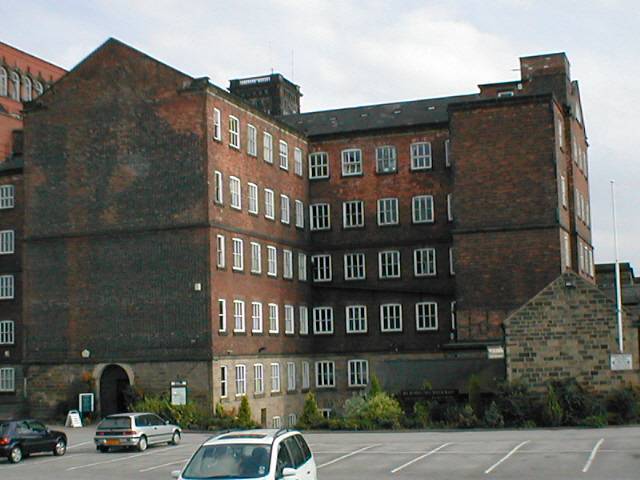 Belper North Mill, rebuilt in 1804 by William Strutt (son of Jedediah) on the lower storeys of the earlier mill that had been destroyed by fire in 1803, embodies the knowledge accumulated from all the earlier experiments William Strutt had made into fire-resistant mill structures and from his close participation in Charles Bage’s pioneering work at Shrewsbury.
Belper North Mill, rebuilt in 1804 by William Strutt (son of Jedediah) on the lower storeys of the earlier mill that had been destroyed by fire in 1803, embodies the knowledge accumulated from all the earlier experiments William Strutt had made into fire-resistant mill structures and from his close participation in Charles Bage’s pioneering work at Shrewsbury.
William Strutt, 1756-1830, was a mechanic and engineer of the highest distinction. He was the first to tackle systematically the threat of fire in textile mills first by cladding with plaster and then by the use of iron and brick.
The north mill is constructed in brick on a stone plinth. Every aspect of the building was designed to resist combustion. The floors are composed of brick and tile supported by arches that spring from cast iron beams. The beams are supported by cast iron columns which, in turn, are linked together by wrought iron ties. Clay pots are used to infill the floor arches in the bays above the water wheel so reducing the weight in this area.
The mill was the most technically advanced building of its time, incorporating an iron frame and brick arches, to make the building "Fireproof". It is now recognised as one of the most important industrial buildings in the world.
A cotton mill was a fire hazard. The cotton dust easily ignites and burns through the ceiling and floor timbers. This happened to many mills, including Arkwright's spinning mill at Cressbrook Derbyshire which burnt down in 1785 and was rebuilt in stone in 1787 by Richard Arkwright Jnr, his father having passed away.
To attempt to prevent this, experiments were made to construct a fireproof mill. The floor timbers were replaced with beams of cast iron, (steel was not available till after 1860) and between them low vaults made of brick, having a 9 foot span. Considerable thought was given to the individual building components. For instance, iron beams were 'turtle-backed' that is, deeper in the middle where they were under the greatest stress.
North Mill Basement
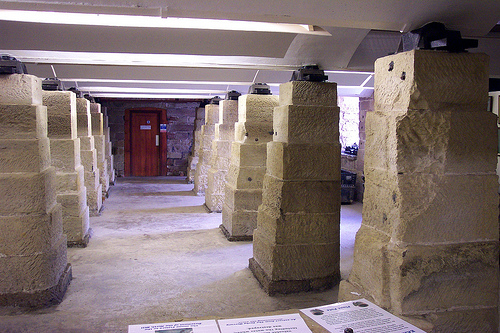 In the basement, the former ground floor of the earlier mill, stone piers carry the cast iron columns which support each of the floors above. The massive stone buttresses which were once a feature of this space have been removed.
In the basement, the former ground floor of the earlier mill, stone piers carry the cast iron columns which support each of the floors above. The massive stone buttresses which were once a feature of this space have been removed.
The school (The 6th floor)
The 6th floor is the building's attic with its unique internal gutters and was used from an early period as a schoolroom, where Sunday classes in the three 'R's were run for the mill's child employees. Eventually to educate the local children, a Lancastrian School was built in Long Row.
Early Central Heating
William Strutt was recognised by his contemporaries as the leading exponent of hot-air heating systems for large buildings and the stove, which was once located in the windowless masonry block occupying the two northern bays of the western end of the North Mill, is of some interest, though it is now recognised that mill buildings of an earlier generation, as for example those at Cromford, had hot-air heating systems before William Strutt’s experiments began.
Other Mill Buildings
A variety of other buildings sprang up around the first mills, including this Round Mill built in 1811. The photo (credit to Mr J Peter R Pym) was taken from the South Tower in the 1900's. Ashbourne Road runs across the front of the picture. The Mill fell in whilst it was being demolished, killing four men, on 2nd December 1959.
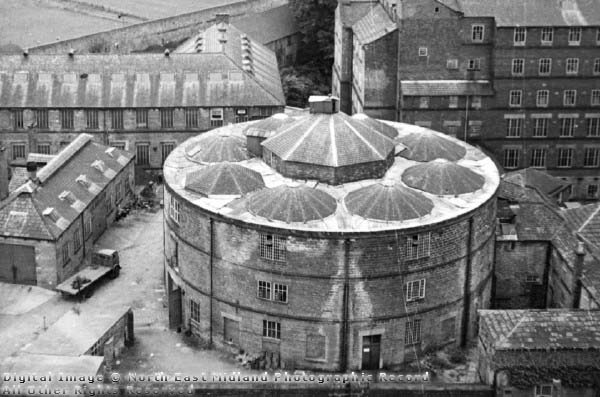
The Belper East Mill (1912)
The East Mill completely overshadows the North Mill. A fortress-like, seven-storey building with four corner turrets, Italianate tower and rows of windows, it was constructed by the English Sewing Cotton Company in 1912 in the distinctive Accrington red-brick, which had by this time become the preferred building material for textile mills - whether built in Lancashire or elsewhere.
It is built around a steel frame, which by 1912 had long been entirely free-standing; unlike William Strutt’s structures, which relied on the walls of the building to support them. No scaffolding was used to build the East Mill. Despite this, there were few accidents during construction. The only death recorded in the press was of labourer Edward Frost of Bonsall, struck by lightning whilst inserting a steel girder in the ground just a week into the project.
Today the building, although used for offices, is largely empty and in a run-down condition.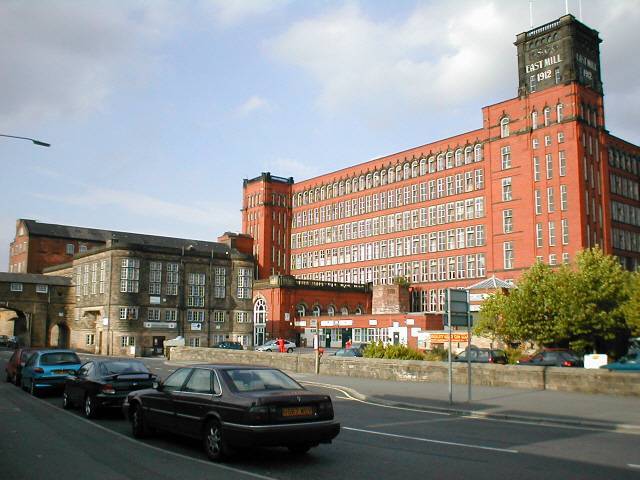
Arched footbridge (circa 1795)
A sandstone bridge linking the two separate areas of the former Strutt Mills complex on either side of the Ashbourne Road. The archway also served a defensive role. Along its length are gun embrasures which protected the West Mill counting house.
The Horseshoe Weir (circa 1797)
The two first mills in Belper, the South Mill and the North Mill, were served by the water retained by Jedediah Strutt’s first weir, a simple structure which spanned the river near the present day railway bridge.
To power the West Mill, Strutt needed a new and very much larger weir. An outline of this structure appears on a plan of 1796, and building began soon after. As the name suggests, the weir is of distinctive shape. It was modified and increased in height in 1819 and 1843 yet remains largely unaltered.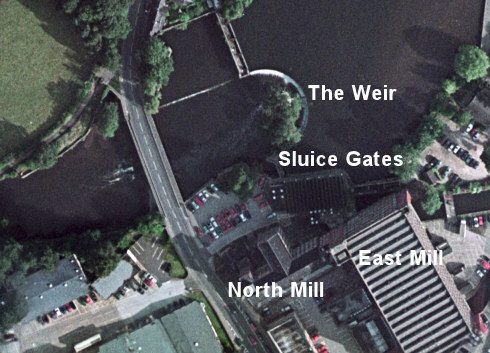
The weir and its associated watercourses altered the river significantly. By 1820, some 5.8 hectares of water had been added to the Derwent immediately above Bridge Foot. Rees’s Cyclopaedia, which was published serially between 1802 and 1820, described the mills at Belper as being “on a scale and most complete we have ever seen, in their dams and their water works”. It is one of the outstanding engineering structures of the late 18th century.
![]() Although the main development of the textile industry occurred with the arrival of Jedediah Strutt, there is some evidence for its presence prior to this. A very early cotton mill was worked by two horses in Paddlewell Yard, c 1730, by Joseph Robinson, spinning raw cotton brought from Manchester by pack horse. (See the page about this HERE).
Although the main development of the textile industry occurred with the arrival of Jedediah Strutt, there is some evidence for its presence prior to this. A very early cotton mill was worked by two horses in Paddlewell Yard, c 1730, by Joseph Robinson, spinning raw cotton brought from Manchester by pack horse. (See the page about this HERE).
SEE ALSO: The Derby Cotton and Silk Mills, a book extract from "A Collection of Fragments Illustrative of the History and Antiquities of Derby" By Robert Simpson Vol II 1826 pages 777-795

